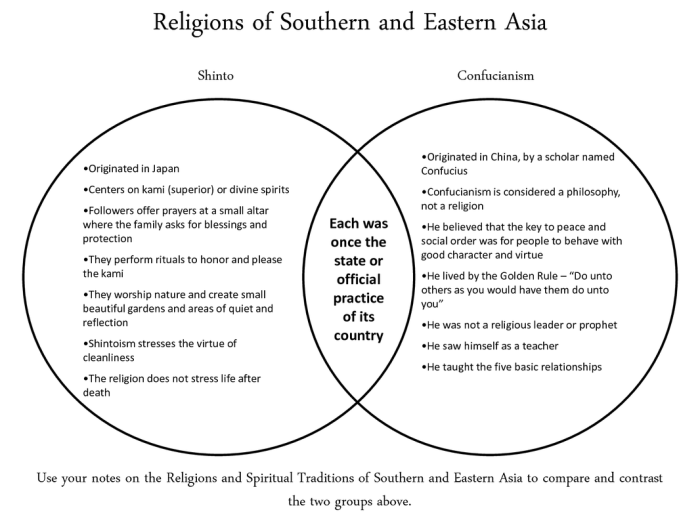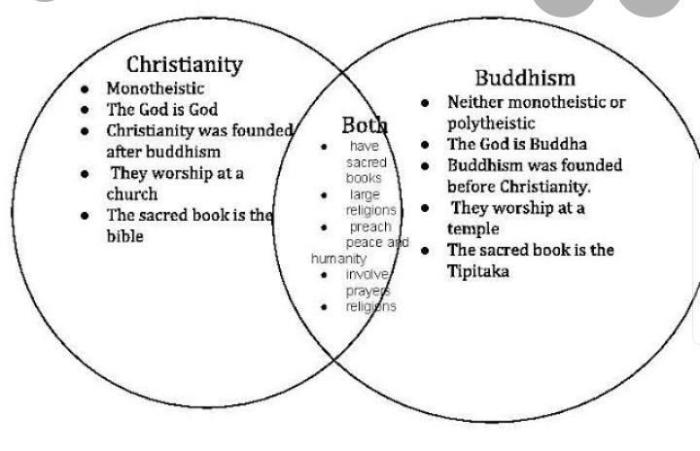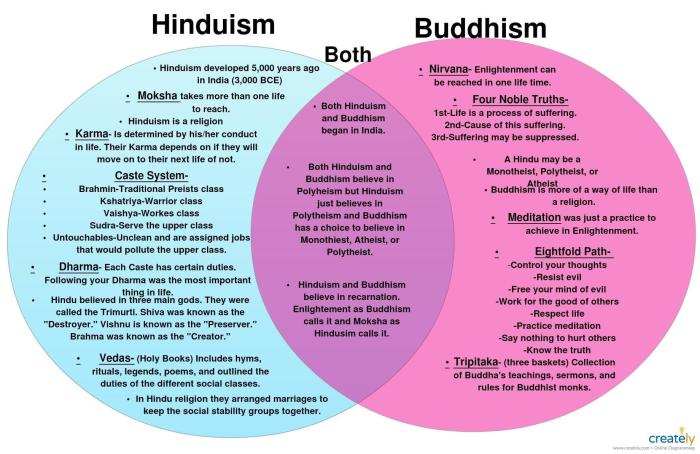Buddhism and Christianity Venn Diagram: Exploring Overlaps and Distinctions opens a window into the fascinating world of comparative religion, inviting readers to delve into a tapestry of beliefs, practices, and historical interactions that have shaped the spiritual landscapes of countless lives.
This comprehensive analysis traces the origins, core tenets, similarities, and differences between these two major world religions, shedding light on their profound impact on human thought and civilization.
Origins and Historical Context
Buddhism and Christianity emerged in different historical contexts and geographical regions. Buddhism originated in the 6th century BCE in India, founded by Siddhartha Gautama, known as the Buddha. Christianity emerged in the 1st century CE in the Roman Empire, founded by Jesus Christ.
Timeline of Significant Events
- 6th century BCE: Birth of Siddhartha Gautama
- 5th century BCE: Buddha’s enlightenment and first teachings
- 1st century CE: Birth of Jesus Christ
- 30 CE: Crucifixion and resurrection of Jesus Christ
- 1st century CE: Spread of Christianity throughout the Roman Empire
- 3rd century CE: Buddhism spreads to China and Japan
- 6th century CE: Christianity becomes the official religion of the Roman Empire
- 13th century CE: Buddhism spreads to Southeast Asia
- 15th century CE: Christianity spreads to the Americas and Africa
Geographical Spread
Buddhism spread eastward from India to China, Japan, Southeast Asia, and eventually to the West. Christianity spread westward from the Roman Empire to Europe, the Americas, and Africa. Both religions have continued to spread and evolve over time, with significant influence on the cultures and societies they have encountered.
Core Beliefs and Practices

Buddhism and Christianity share some fundamental beliefs and practices, while also having significant differences. Both religions emphasize ethical conduct, compassion, and the pursuit of spiritual enlightenment or salvation.
Central Teachings and Beliefs
- Buddhism:Four Noble Truths, Eightfold Path, karma, rebirth
- Christianity:Trinity, life and teachings of Jesus Christ, faith, salvation
Ethical Principles and Moral Codes
- Buddhism:Non-violence (ahimsa), compassion, generosity, right speech, right action, right livelihood
- Christianity:Love thy neighbor, Golden Rule, Ten Commandments
Meditation and Prayer
- Buddhism:Mindfulness meditation, Vipassana meditation, Zen meditation
- Christianity:Prayer, contemplation, intercessory prayer
Similarities and Overlaps: Buddhism And Christianity Venn Diagram

Buddhism and Christianity share several concepts and practices that promote spiritual growth and well-being.
Compassion and Forgiveness
Both religions emphasize the importance of compassion, kindness, and forgiveness. In Buddhism, metta (loving-kindness) and karuna (compassion) are essential qualities for a spiritual practitioner. In Christianity, love and forgiveness are central teachings of Jesus Christ.
Pursuit of Spiritual Enlightenment, Buddhism and christianity venn diagram
Buddhism and Christianity both offer paths to spiritual enlightenment or salvation. In Buddhism, the goal is to achieve nirvana, a state of liberation from suffering. In Christianity, the goal is to achieve salvation through faith in Jesus Christ and a life lived according to his teachings.
Differences and Distinctions

Despite their similarities, Buddhism and Christianity have significant differences in their views on God, salvation, and the afterlife.
Views on God
Buddhism does not have a concept of a creator God. Instead, it emphasizes the impersonal nature of existence and the interconnectedness of all things. Christianity, on the other hand, believes in a personal God who created the universe and is actively involved in human affairs.
Salvation
In Buddhism, salvation is achieved through individual effort and the practice of the Eightfold Path. In Christianity, salvation is achieved through faith in Jesus Christ and the grace of God.
Afterlife
Buddhism believes in reincarnation, the cycle of rebirth based on one’s karma. Christianity believes in heaven and hell, eternal rewards and punishments based on one’s faith and actions.
Influence and Interaction
Buddhism and Christianity have had a long history of interaction and influence, both positive and negative.
Historical Interactions
- Buddhist ideas influenced early Christian thinkers, such as Clement of Alexandria and Origen.
- Christian missionaries in China encountered and engaged with Buddhism, leading to some syncretic practices.
- Buddhism spread to Japan through Korea, where it encountered and influenced Shintoism.
Influence of Buddhist Ideas on Christian Thought
- Concept of compassion and loving-kindness
- Emphasis on meditation and contemplation
- Ideas of non-attachment and impermanence
Influence of Christian Ideas on Buddhist Thought
- Belief in a creator God
- Concept of salvation through faith
- Emphasis on love and forgiveness
Contemporary Relevance

Buddhism and Christianity continue to be relevant in the modern world, offering guidance and support to millions of people.
Role in Addressing Social Issues
- Both religions emphasize compassion and social justice.
- Buddhist and Christian organizations are involved in humanitarian work, such as disaster relief and education.
Promoting Interfaith Dialogue
- Buddhism and Christianity share common values and principles.
- Interfaith dialogue promotes understanding and cooperation between different religions.
Contribution to Personal Growth and Well-being
- Buddhist and Christian teachings can provide guidance for ethical living and spiritual growth.
- Mindfulness meditation and prayer can reduce stress and promote inner peace.
Answers to Common Questions
What are the key differences between Buddhism and Christianity?
Buddhism emphasizes the concept of karma and reincarnation, while Christianity focuses on the belief in a single life and salvation through faith in Jesus Christ.
What are the similarities between Buddhism and Christianity?
Both religions promote compassion, forgiveness, and the pursuit of spiritual enlightenment, and they share practices such as meditation and prayer.
What is the historical significance of the Buddhism and Christianity Venn Diagram?
The diagram helps to illustrate the historical interactions and influences between Buddhism and Christianity, particularly during their early development and spread.

